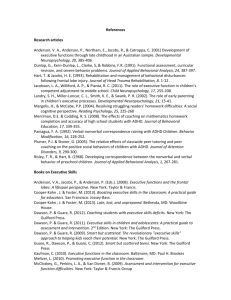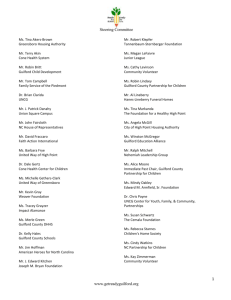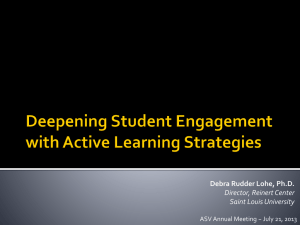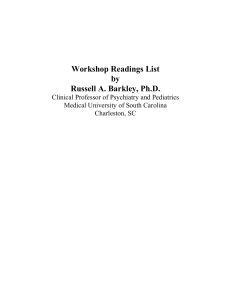Executive Functions Reference List
advertisement
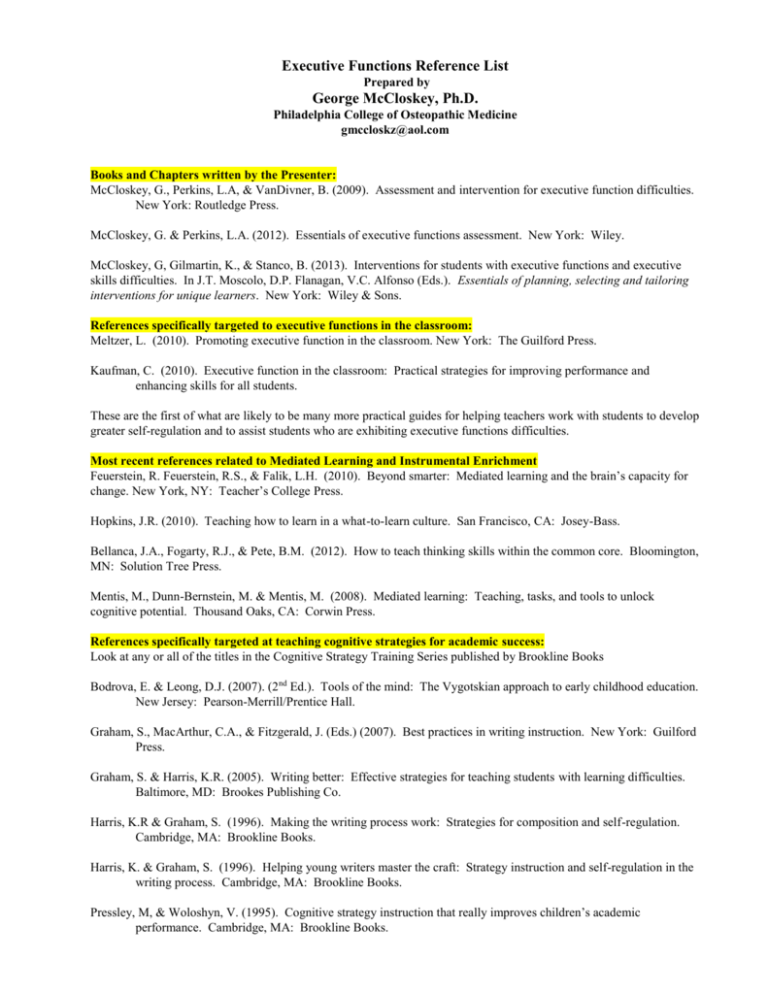
Executive Functions Reference List Prepared by George McCloskey, Ph.D. Philadelphia College of Osteopathic Medicine gmccloskz@aol.com Books and Chapters written by the Presenter: McCloskey, G., Perkins, L.A, & VanDivner, B. (2009). Assessment and intervention for executive function difficulties. New York: Routledge Press. McCloskey, G. & Perkins, L.A. (2012). Essentials of executive functions assessment. New York: Wiley. McCloskey, G, Gilmartin, K., & Stanco, B. (2013). Interventions for students with executive functions and executive skills difficulties. In J.T. Moscolo, D.P. Flanagan, V.C. Alfonso (Eds.). Essentials of planning, selecting and tailoring interventions for unique learners. New York: Wiley & Sons. References specifically targeted to executive functions in the classroom: Meltzer, L. (2010). Promoting executive function in the classroom. New York: The Guilford Press. Kaufman, C. (2010). Executive function in the classroom: Practical strategies for improving performance and enhancing skills for all students. These are the first of what are likely to be many more practical guides for helping teachers work with students to develop greater self-regulation and to assist students who are exhibiting executive functions difficulties. Most recent references related to Mediated Learning and Instrumental Enrichment Feuerstein, R. Feuerstein, R.S., & Falik, L.H. (2010). Beyond smarter: Mediated learning and the brain’s capacity for change. New York, NY: Teacher’s College Press. Hopkins, J.R. (2010). Teaching how to learn in a what-to-learn culture. San Francisco, CA: Josey-Bass. Bellanca, J.A., Fogarty, R.J., & Pete, B.M. (2012). How to teach thinking skills within the common core. Bloomington, MN: Solution Tree Press. Mentis, M., Dunn-Bernstein, M. & Mentis, M. (2008). Mediated learning: Teaching, tasks, and tools to unlock cognitive potential. Thousand Oaks, CA: Corwin Press. References specifically targeted at teaching cognitive strategies for academic success: Look at any or all of the titles in the Cognitive Strategy Training Series published by Brookline Books Bodrova, E. & Leong, D.J. (2007). (2 nd Ed.). Tools of the mind: The Vygotskian approach to early childhood education. New Jersey: Pearson-Merrill/Prentice Hall. Graham, S., MacArthur, C.A., & Fitzgerald, J. (Eds.) (2007). Best practices in writing instruction. New York: Guilford Press. Graham, S. & Harris, K.R. (2005). Writing better: Effective strategies for teaching students with learning difficulties. Baltimore, MD: Brookes Publishing Co. Harris, K.R & Graham, S. (1996). Making the writing process work: Strategies for composition and self-regulation. Cambridge, MA: Brookline Books. Harris, K. & Graham, S. (1996). Helping young writers master the craft: Strategy instruction and self-regulation in the writing process. Cambridge, MA: Brookline Books. Pressley, M, & Woloshyn, V. (1995). Cognitive strategy instruction that really improves children’s academic performance. Cambridge, MA: Brookline Books. References Page 2 Wood, E., Woloshyn, V., & Willoughby, T. (1999). Cognitive strategy instruction for middle and high schools. Cambridge, MA: Brookline Books. Gaskins, I. & Elliott, T. (1991). Implementing cognitive strategy instruction across the school: The benchmark manual for teachers. Cambridge, MA: Brookline Books. Scheid, K. (1999). Helping students become strategic learners: Guidelines for teaching. Cambridge, MA: Brookline Books. Mastropieri, M. & Scruggs, T. (1991). Teaching students ways to remember: Strategies for learning mnemonically. Cambridge, MA: Brookline Books. Scruggs, T & Mastropieri, M. (1992). Teaching test-taking skills: Helping students show what they know. Cambridge, MA: Brookline Books. Ciborowski, J. Textbooks and the students who can’t read them: A guide for teaching of content. The following reading program resources include information on reading comprehension strategy instruction: Comprehension Plus The Comprehension Tool Kit University of Nebraska – Lincoln Cognitive Strategy Instruction link: http://cehs.unl.edu/csi/teachingstrategy.shtml Website for information on Cognitive Strategy Instruciton: Intervention Idea Sources for students with Executive Function difficulties, ADHD and/or Conduct Problems Dawson, P. & Guare, R. (2012). Coaching students with executive skills deficits. New Tork: The Guilford Press. Guare, R., Dawson, P.D., & Guare, C. (2013). Smart but scattered teens: The executive skills program for helping teens reach their potential. NY: The Guilford Press. Dawson, P. & Guare, R. (2010) (2nd Ed.). Executive skills in children and adolescents: A practical guide to assessment and intervention. New York: Guilford Press. A practical guide for clinicians dealing with children & adolescents with executive function difficulties. Cooper-Kahn, J. & Dietzel, L. (2008). Late, lost, and unprepared: A Parents’ guide to helping children with executive functioning. Bethesda, MD: Woodbine House. As stated in the title, a practical guide for parents. This book offers practical suggestions for dealing with a number of executive function difficulties exhibited by children that are the most frequently encountered by parents. Greene, R.W. (2009). Lost at school. New York: Scribner. Applies the concepts presented in Greene’s other books but does so in a format that makes the information exceptionally accessible and compelling. Combines a case study narrative with instructive “how to” passages and question and answer sections. Possibly the most practical description ever written of how to apply an intervention approach in general education classrooms. Greene, R.W. (2001). The explosive child: A new approach for understanding and parenting easily frustrated, chronically inflexible children. New York: Harper-Collins Publishers, Inc. An excellent sourcebook for developing and implementing interventions for children with a specific subset of executive function deficits (inflexibility and emotional control problems resulting in explosive episodes). Reading this book will help a professional understand how executive functions can affect behavior and how deficiencies can be dealt with. The principles discussed in the book can be applied to milder forms of executive deficits just as effectively. The orientation is primarily focused on helping parents. School-based practitioners References Page 3 will be better served by reading Lost at School. Greene, R.W. & Ablon, J.S. (2006). Treating explosive kids: The collaborative problem-solving approach. New York: The Guilford Press. An extension of The Explosive Child; Greene & Ablon introduce the collaborative problem-solving approach as a formal framework for describing Greene’s approach with children experiencing difficulties with the modulation of perception, emotion, cognition and action, especially emotion. Shure, M.B. (2005). Thinking parent, thinking child: How to turn your most challenging everyday problems into solutions. New York: Research Press. Barkley, R.A. (2006). Attention-Deficit Hyperactivity Disorder: A handbook for diagnosis and treatment. (3rd Ed.) New York: The Guilford Press. Barkley’s (2006) book is a good source of information about classroom interventions that can be used effectively while maintaining a student in the regular classroom (see Chapters 15 and 16) , as well as many other approaches to intervention for ADHD (Section III, Chapters 12-22). Barkley, R.A. (2000). Taking charge of ADHD. The complete, authoritative guide for parents. (2nd Ed.). New York: The Guilford Press. A very practical guide for parents of children with ADHD and some aspects of executive function deficiencies. Hallowell, E.M., & Ratey, J.J. (1994). Driven to distraction: Recognizing and coping with attention deficit disorder from childhood through adulthood. Well-written, easy to read. Provides a very good understanding of ADHD and how to deal with the symptoms. Jones, Claire B. (1999). Sourcebook for children with attention deficit disorder (2nd Edition). San Antonio, TX: The Psychological Corporation. Jones, Claire B. (1996). Attention deficit disorder: Strategies for school-age children. San Antonio, TX: The Psychological Corporation. Jones, Claire B. (Ed.) (1999) Parent articles about ADHD. San Antonio, TX: The Psychological Corporation. All three of the Jones references emphasize practical intervention strategies for classroom and home. Many of the ADHD strategies in these books can be used with children with executive function difficulties. Teeter, P.A. (1998). Interventions for ADHD: Tretment in Developmental Context. New York: The Guilford Press. A thorough treatment of intervention issues from early childhood through adulthood. Zeigler-Dendy, C. A. (2000). Teaching teens with ADD and ADHD: A quick reference guide for teachers and parents. See especially Chapter 3, Executive Function and Organizational Skills. Schwartz, J.M. (1996). Brain Lock: Free yourself from obsessive-compulsive behavior: A four-step self-treatment method to change your brain chemistry. Schwartz’s ground-breaking therapeutic approach that teaches OCD sufferers how to take control of their executive function processes to overcome their problem behaviors. Schwartz offers hard-core scientific proof that it is possible to alter neural activation patterns to change the efficiency of executive function processes. Segal, Z.V., Williams, J.M.G., & Teasdale, J.D. (2002). Mindfulness-based cognitive therapy for depression: A new approach to preventing relapse. New York: The Guilford Press. This book describes in rationale and the procedures for conducting a form of cognitive therapy that integrates mindfulness-based meditative practice as part of the therapeutic process. Bersma, D., & Visscher, M. (2003). Yoga games for children: Fun and fitness with postures, movement and breath. Alameda, CA: Hunter House Inc. Games for children ages 3-12. References Page 4 General Intervention References and Related Topics: Cooper-Khan, J. & Foster, M. (2013). Boosting executive skills in the classroom: A practical guide for educators. San Francisco, CA Josey-Bass (John Wiley & Sons). Yeager, D. & Yeager, M. (2008). Simon says pay attention!: Help for children with ADHD. Lafayette, LA: Golden Path Games. Grossberg, B. (2009). Test success: Test-taking and study strategies for all students, including those with ADD and LD. Plantation, FL: Specialty Press. Rush Neurobehavioral Center (2010). A blueprint for success: Building an executive functions foundation for middle school students. Skokie, IL: Rush Neurobehavioral Center. Fiore, N. (2007). The now habit: The Fiore productivity program for overcoming procrastination and enjoying guilt-free play. New York: Jeremy P Tarcher-Penguin. Ferrari, J.R. (2010). Still Procrastinating?: The no-regrets guide to getting it done. Hoboken, NJ: John Wiley & Sons. Kulman, R. (2012). Train your brain for success: A teenager’s guide to executive functions. Plantation, FL: Specialty Press. Moraine, P. (2012). Helping students take control of everyday executive functions: The attention fix. Philadelphia, PA: Jessica Kingsley Publishers. McGonigal, K. (2012). The willpower instinct: How self-control works, why it matters, and what you can do to get more of it. New York: Penguin Group. Baumeister, R.F., & Tierney, J. (2011). Willpower: Rediscovering the greatest human strength. New York: The Penguin Press. Siegel, D.J. (2011). Mindsight: The new science of personal transformation. New York: Bantam Books Trade Paperbacks. Greenland, S.K. (2010). The mindful child: How to help your kid manage stress and become happier, kinder, and more compassionate. New York: Free Press. Shure, M.B. & DiGeronimo, T.F. (1994). Raising a thinking child: Help your child to resolve everyday conflicts and get along with others. New York: Pocket Books. Siegel, D.J. (2012) (2nd. Ed.). The developing mind: How relationships and the brain interact to shape who we are. New York: The Guilford Press. Hall, H.V. & Sbordone, R.J. (Eds.) (1993). Disorders of executive functions: Civil and criminal law applications. Irvine, CA PMD Publishers Group. Zeigler-Dendy, C.A. (2011). Teaching teens with ADD, ADHD and executive function deficits: A quick reference guide for teachers and parents. Bethesda, MD: Woodbine House. Rabbitt, P. (Ed.) (1997). Methodology of frontal and executive function. New York: Psychology Press. Siegel, D.J. (2007). The mindful brain: Reflection and attunement in the cultivation of well-being. New York: W.W. Norton & Co. Siegel, D.J. & Bryson, T.P. (2011). The whole-brain child: 12 revolutionary strategies to nurture your child’s developing mind. New York: Delacorte Press. References Page 5 Barkley, R.A. (2012). Barkley Deficits in Executive Functioning Scale – Children and Adolescents. New York: The Guilford Press. Davis, L., Sirotowitz, S. & Parker, H.C. (1996). Study strategies made easy: A practical plan for school success. Plantation, FL: Specialty Press. Kahneman, D. (2011). Thinking, fast and slow. New York: Farrar, Straus, & Giroux. Dehaene, S. (2014). Consciousness and the brain: Deciphering how the brain codes our thoughts. New York: Viking. Pink, D.H. (2009). Drive: The surprising truth about what motivates us. New York: Riverhead Books. Goldstein, J. (1994). Insight meditation: The practice of freedom. Boston, MA Shambhala. Levine, Melvin D. (1998). Developmental Variation and Learning Disorders. Cambridge: Educators Publishing Service. Good recommendations for dealing with executive function and attention deficits can be found in separate chapters of the text addressing areas such as Attention, Memory, Higher Order Cognition, Social Ability, and Reading. Steinberg, L. (2004). The 10 basic principles of good parenting. New York: Simon & Schuster. What does a parent who demonstrates the effective use of executive functions do while parenting that will foster the development of their child’s executive functions? Read this book and you will find out. Watson, S.M.R., Westby, C.E. (2003). Strategies for addressing the executive function impairments of students prenatally exposed to alcohol and other drugs. Communication Disorders Quarterly, 24(4), 194-204. Singer, B.D. & Bashir, A.S. (1999). What are Executive Functions and Self-Regulation and what do they have to do with language learning disabilities. Language, Speech and Hearing Services in the Schools. July, Vol 30 No.3. Cozolino, L. (2002). The neuroscience of psychotherapy: Building and rebuilding the human brain. New York: W.W. Norton & Co. Highlights the role of executive capacities and therapy as a means of developing greater executive control. Feuerstein, R. (1980). Instrumental enrichment: An intervention program for cognitive modifiability. Although this original reference is more than 20 years old, the concepts were far ahead of their time; we are only now beginning to catch on to what this text so eloquently and thoroughly described more than two decades ago. Kelley, Robert E. (1998). How to be a star at work: Nine breakthrough strategies you need to succeed. New York: Random House. Kelley’s nine breakthrough strategies sound very much like operational definitions of the effective use of executive mental functions in the workplace. Assagioli, Roberto. (2000). Psychosynthesis: A collection of basic writings. Synthesis Center. This classic text (originally published in the U.S. in 1965) on humanistic-oriented clinical methods for improving “the self” can be viewed as a primer for awakening and/or developing executive functions related to self-regulation of behavior; in Assagioli’s words, “strengthening the will.” Evans, J. R. & Abarbanel, A. (1999). Introduction to quantitative EEG and neurofeedback. New York: Academic Press. This book contains a discussion of the clinical application of neurofeedback in the treatment of ADHD and executive function deficits as well as reports of empirical studies of the effectiveness of neurofeedback in clinical settings. References Page 6 Segal, Z.V., Williams, J.M.G., & Teasdale, J.D. (2002). Mindfulness-based cognitive therapy for depression: A new approach to preventing relapse. New York: Guilford Press. This book describes a combination of meditation and cognitive behavior therapy for treating depression especially for persons who are prone to relapse. The techniques described clearly demonstrate an effective means for improving executive functions in order to control depression. Prochaska, J.O., Norcross, J.C., DiClemente, C.C. (1994). Changing for good: A revolutionary six-stage program for overcoming bad habits and moving your life positively forward. Perspective Broadening: An Integral Vision as the Big Picture to guide thinking about Executive Functions Wilber, Ken. (2000). A theory of everything: An integral vision for business, politics, science, and spirituality. Boston: Shambhala. Wilber, Ken. (2000). Integral Psychology: Consciousness, spirit, psychology, therapy. Boston: Shambhala. Wilber, Ken. (1997). A brief history of everything. Boston: Shambhala. Wilber, Ken. (1983). Eye to eye: The quest for the new paradigm. Boston: Shambhala. Wilber, Ken. (1977). The spectrum of consciousness.. (or see a more readable presentation of the ideas in the book entitled: No Boundary: Eastern and western approaches to personal growth (1979, 2002). Boston: Shambhala. Visser, Frank. (2003). Ken Wilber: Thought as passion. Albany, NY: State University of New York Press. Reynolds, B. (2004). Embracing reality: The integral vision of Ken Wilber: A historical survey and chapter-by-chapter guide to Wilber’s major works. New York: Jeremy P. Tarcher. Combs, Allan. (2002). The radiance of being: Understanding the grand integral vision; Living the integral life. (2 nd Ed.) St. Paul, Minnesota: Paragon house. Assagioli, Roberto. (2000). Psychosynthesis: A collection of basic writings. Synthesis Center. This classic text (originally published in the U.S. in 1965) on humanistic-oriented clinical methods for improving “the self” can be viewed as a primer for awakening and/or developing executive functions related to self-regulation of behavior; in Assagioli’s words, “strengthening the will.” Frankl, Victor E. (1959). Man’s search for meaning. New York: Pocket Books. The revised and updated version of the original work was published by Pocket Books (Simon & Schuster) in 1985. This classic work describes Victor Frankl’s experiences as a prisoner in a concentration camp during World War II. The content of this book formed the basis for the development of Frankl’s unique approach to the treatment of existential dilemma’s that has come to be known as Logotherapy. A must read for those who deal with Self-Generation executive function difficulties. New publications on Executive Functions and related topics: October 2014
